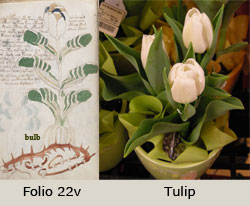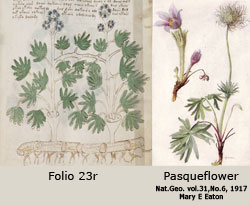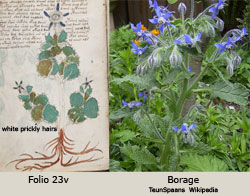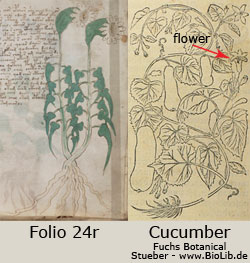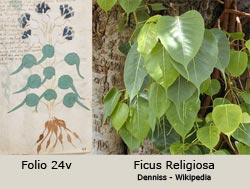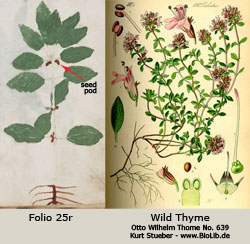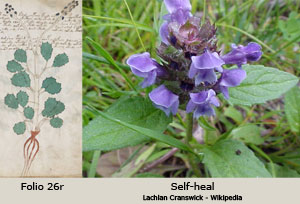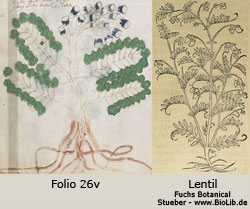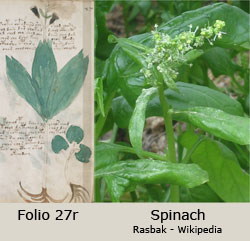The Voynich Botanical Plants
Folio 22v, Tulips, are native to southern Europe, North Africa, and Asia. They are perenniel bulbs and new bulbs are often produced on the ends of stolons and covered with hairy papery coverings. Tulips have from 2 to 6 oblong fleshy leaves, alternately arranged, and large flowers that are produced on stems normally lacking bracts. There are variegated varieties caused by a viral infection. The virus weakens the plants and has therefore been nearly eradicated from the fields where it is grown.
Folio 23r, Pasque flower (Pulsatilla vulgaris), is found in short clumps in the meadows of Eurasia. It has finely-dissected leaves; purple, bell-shaped flowers; and a woody, rhizomous root. It is one of the first flowers to bloom in the spring, hence the name Pasque meaning Easter (Passover). As a member of the Ranunculaceae family, the plant is very toxic, producing cardiogenic toxins and oxytoxins which slow the heart in humans. The flower is useful to treat eye diseases such as cataracts.
Folio 23v, Borage or star flower (Borago officinalis L.), is an annual herb that originated in Syria but has naturalized in the Mediterranean and North Africa. The plant is covered with stiff, white, prickly hairs. The simple leaves are alternate and the flowers are small, blue, or pink, with five, narrow, triangular-pointed petals. The young leaves are eaten in salads. Medically it is used for its anti-inflammatory properties.
Folio 24r, Cucumber (Cucumis sativus), originated in India but has been cultivated for at least 3,000 years in Western Asia and was probably introduced to other parts of Europe by the Romans. This creeping vine grows up trellises or other supporting frames, wrapping around ribbing with thin, spiraling tendrils. The plant has large leaves that form a canopy over the roughly cylindrical fruit. The Romans are reported to have used cucumbers to treat scorpion bites, bad eyesight, and to scare away mice.
Folio 24v, Sacred Fig or Bo-Tree (Ficus religiosa), is a native tree of India. The leaves are cordate in shape with a distinctive extended tip and the fruit is a small purple fig. The leaves from this tree are the only match we have found for the leaves illustrated in Folio 24v. This tree is considered sacred by the followers of Buddhism and the founder of this religion, Siddhartha Gautama, was sitting under it when he was spiritualy awakened.
Folio 25r, Wild Thyme, is a small, aromatic, perennial shrub native to the Mediterranean. Its leaves are arranged in pairs along the stalk. The flowers, not shown in the folio, are pink to lilac clusters, and the seedpods contain tiny nutlets. The leaves are used as flavoring in cooking. Thymol, the oil distilled from thyme, has many medical uses. The Romans used thyme as a remedy for depression.
Folio 25v, Woad (Isatis tinctoria), is a flowering plant of the Cabbage family. It has been cultivated throughout Europe, especially in Western and Southern Europe, since ancient times and was the only source for blue dye available until the end of the sixteenth century. In Medieval times, Tuscany in Italy was one of the centers of woad cultivation. The dye was used to dye textiles, and the illustrator of the VM may have used a woad-based pigment for blue paint.
Folio 26r, Self-heal (Prunella vulgaris), is a low growing plant native to Europe. It is a member of the mint family. The oblong leaves grow on short stalks in pairs down the stem. They are rough and their margins are fringed with tiny hairs. At the end of the stem is a spike of blue flowers, arranged in regular whorls. It has a normal spreading root. Self-heal got its name from its antiseptic and antibacterial properties, and was found to be useful in cases of food poisoning. The photograph of self-heal was taken by Lachlan Cranswick
Folio 26v, Lentil (Lens culinaris), originated in the Near East, and was one of the first crops to be domesticated in Neolithic times. It is a bushy plant of the legume family grown for its seeds which are high in protein. By 6,000 BC legumes became a staple in the human diet as a supplement for protein where there was not enough meat. Folio 26v could also represent a chickpea plant, another member of the legume family.
Folio 27r, Spinach (Spinacia oleracea), is thought to have originated in Persia. The Moors introduced it into Europe around the 15th century. Dishes containing spinach are referred to as “Florentine” because it was the favorite vegetable of Catherine de Medici. Spinach has alternate, simple, ovate to triangular-based leaves; inconspicuous, yellow-green flowers; and a normal spreading root system. The benefits of eating spinach are well known due to the songs of Popeye and Shirley Temple. The vegetable is rich in iron.
